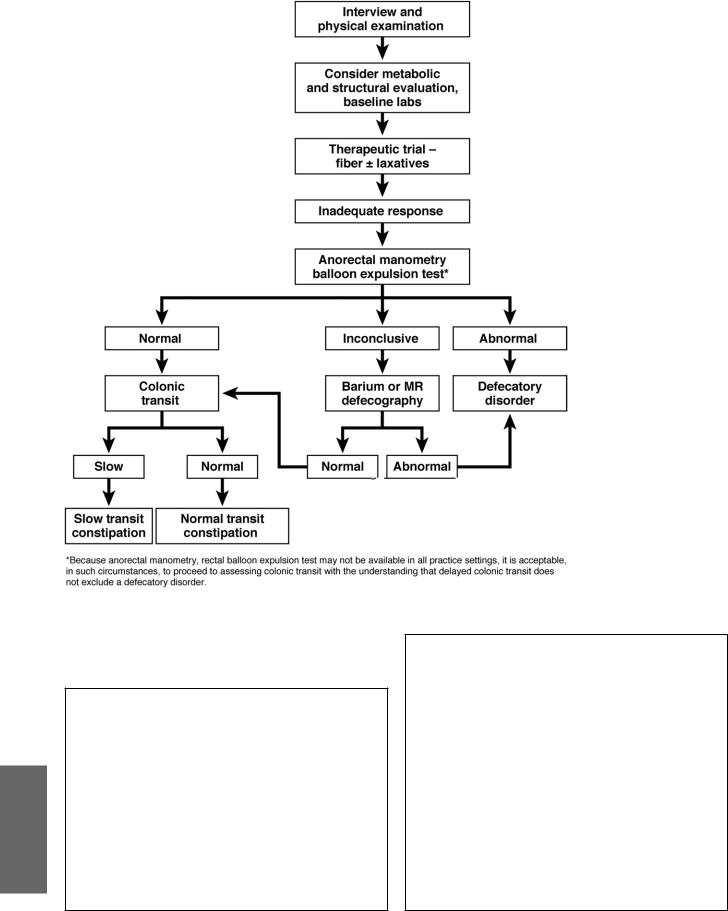
- •Clinical Subgroups
- •Defecatory Disorders
- •Combination Disorders
- •Clinical Evaluation
- •Clinical Assessment of Constipation
- •Diagnostic Tests
- •What Tests Should Be Performed to Assess for Medical Causes of Constipation?
- •Medical Management
- •Pelvic Floor Retraining
- •What Is the Initial Treatment Approach for Constipation?
- •Surgical Treatment of Constipation
- •What Approaches Should Be Considered for Constipation Unresponsive to Initial Approaches?
- •Acknowledgments
- •Reference

January 2013 |
AGA 213 |
puborectalis muscle, which should also contract during squeeze. Acute localized tenderness to palpation along the puborectalis is a feature of the levator ani syndrome. Finally, the patient should be instructed to integrate the expulsionary forces by requesting that she or he “expel my finger.”
●An examination should then be conducted to evaluate for a rectocele or consideration be given to gynecologic consultation.
Although a careful digital rectal examination is useful for identifying pelvic floor dysfunction, a normal examination does not exclude this diagnosis. After the initial history and physical examination, a set of focused tests should be considered to exclude disorders that are either treatable (eg, hypothyroidism) or important to diagnose early (eg, colon cancer). However, data do not exist to strictly evaluate and define the tests that need to be performed. A complete blood cell count should be performed. Although metabolic tests (thyroid-stimulat- ing hormone, serum glucose, creatinine, and calcium) are often performed, their diagnostic utility and costeffectiveness have not been rigorously evaluated and are probably low. A structural evaluation of the colon may be appropriate in certain circumstances, especially if the patient has alarm symptoms or has abrupt onset of constipation or is older than 50 years and has not undergone previous screenings for colorectal cancer. Depending on the circumstances, colonoscopy, computed tomographic colonography, or flexible sigmoidoscopy and barium enema will effectively exclude lesions that could cause constipation.
If this evaluation uncovers a secondary cause for constipation, the appropriate treatment can be offered. The patient’s medications can be adjusted when possible to avoid those with constipating effects. A trial of fiber and/or over-the-counter laxatives can be instituted.
Clinical Assessment of Constipation
If feasible, discontinue medications that can cause constipation before further testing (strong recommendation, low-quality evidence).
A careful digital rectal examination that includes assessment of pelvic floor motion during simulated evacuation is preferable to a cursory examination without these maneuvers and should be performed before referral for anorectal manometry. However, a normal digital rectal examination does not exclude defecatory disorders (strong recommendation, moderate-quality evidence).
Diagnostic Tests
Patients who do not respond to these measures may benefit from special testing and treatments; these can be presented most simply as an algorithm (Figure 1).
This algorithm starts by recommending anorectal testing for patients who do not respond to a trial of laxatives and/or fiber. Anorectal testing is simple and safe and can potentially modify management; a rectal balloon expulsion test is also inexpensive. There is evidence that pelvic floor retraining is superior to laxatives for defecatory disorders. Hence, anorectal testing may be considered earlier when symptoms or signs strongly suggest pelvic floor dysfunction. Interpretation of any single test must be guarded, because it must be recognized that patient cooperation and understanding comprise an important voluntary component of most tests of anorectal function. The tests themselves must be in a setting as private as possible to reduce embarrassment and facilitate cooperation. Ideal conditions are often not possible. Although anorectal manometry and a rectal balloon expulsion test generally suffice to diagnose or exclude a defecatory disorder, defecography, which is generally performed with barium, or at some centers with magnetic resonance imaging, is useful if results are inconclusive.
Up to 50% of patients with defecatory disorders also have slow colonic transit. Therefore, slow colonic transit does not exclude a defecatory disorder. In addition, coexistent slow colonic transit does not alter the management of defecatory disorders. In contrast to the previous version of this guideline, assessment of colonic transit is recommended only after excluding a defecatory disorder or as shown later during management in Figures 2 and 3. After excluding a defecatory disorder, consideration should be given to assessing colonic transit by radiopaque markers, scintigraphy, or a wireless motility capsule in patients with persistent symptoms while being treated with laxatives. Identifying slow colonic transit may reassure patients about the pathophysiology of their symptoms, serve as an objective marker for documenting the response to therapy, and also provide the physician with the rationale for treating patients with newer, often more expensive treatments. At present, the medical approaches used for managing NTC and STC are similar. However, the major pharmacologic trials in chronic constipation did not assess if the response to therapy is influenced by colonic transit. Although newer agents may also be considered without assessing colonic transit, the long-term side effects, if any, of these agents are unknown and exposure to such potential risks might be more appropriate in patients with more severe forms of constipation associated with slow transit. Hence, we empirically recommend assessing colonic transit in patients with chronic constipation whose symptoms do not respond to laxatives or first-line pharmacologic therapy.
At the conclusion of this initial evaluation, the patient with constipation can be tentatively diagnosed as having
(1) NTC or, in patients who also have pain and other features of the disorder, irritable bowel syndrome; (2) STC; (3) defecatory disorder, (4) a combination of STC and defecatory disorder; or (5) secondary constipation (ie, secondary to an organic disease such as mechanical obstruction, systemic disease, or side effect of a drug).
AGA

214 AGA |
GASTROENTEROLOGY Vol. 144, No. 1 |
AGA
What Tests Should Be Performed to Assess for Medical Causes of Constipation?
In the absence of other symptoms and signs, only a complete blood cell count is necessary (strong recommendation, low-quality evidence).
Unless other clinical features warrant otherwise, metabolic tests (glucose, calcium, sensitive thyroid-stimulating hormone) are not recommended for chronic constipation (strong recommendation, moderate-quality evidence).
A colonoscopy should not be performed in patients without alarm features (eg, blood in stools, anemia, weight loss) unless age-appropriate colon cancer screening has not been performed (strong recommendation, moderate-quality evidence).
Figure 1. Treatment algorithm for chronic constipation. MR, magnetic resonance.
Anorectal manometry and a rectal balloon expulsion should be performed in patients who fail to respond to laxatives (strong recommendation, moderate-quality evidence).
Defecography should not be performed before anorectal manometry and a rectal balloon expulsion test (strong recommendation, low-quality evidence).
Defecography should be considered when results of anorectal manometry and rectal balloon expulsion are inconclusive for defecatory disorders (strong recommendation, low-quality evidence).
Colonic transit should be evaluated if anorectal test results do not show a defecatory disorder or if symptoms persist despite treatment of a defecatory disorder (strong recommendation, low-quality evidence).
